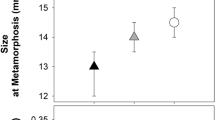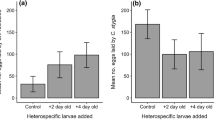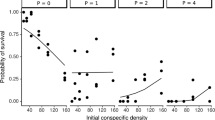Abstract
Life history trade-offs in reproductive strategy are often invoked as ecological agents of evolutionary change, despite a limited amount of experimental data from the field. The larval deposition strategy of Allobates femoralis was tested in Southeastern Peru using a blocked, fully crossed experimental design. Arrays of four pools were used to test the effects of pool size and the presence of a predatory insect (Belostomatid) on the deposition behavior of A. femoralis. Further experiments investigated the colonization of insect predators into potential larval habitats and interactions between predatory insects. Results suggest that pool size, the presence of predatory aquatic insects, and interactions between predators, influence larval deposition in A. femoralis. Similar ecological interactions may have driven toxic dendrobatids to the use of arboreal phytotelmata and associated derived reproductive strategies.




Similar content being viewed by others
References
Adams MJ, Claeson S (1998) Field response of tadpoles to conspecific and heterospecific alarm. Ethology 104(11):955–961
Aichinger M (1991) Tadpole transport in relation to rainfall, fecundity and body size in five species of poison-dart frogs from Amazonian Peru. Amphibia-Reptilia 12:49–55
Alton LA, White CR, Wilson RS, Franklin CE (2012) The energetic cost of exposure to UV radiation for tadpoles is greater when they live with predators. Funct Ecol 26(1):94–103
Bickford DP (2004) Differential parental care behaviors of arboreal and terrestrial microhylid frogs from Papua New Guinea. Behav Ecol Sociobiol 55:402–409
Brodie EDJ, Formanowicz DRJ (1983) Prey size preference of predators: differentail vulnerability of larval anurans. Herpetologica 39:67–75
Brown JL, Twomey E, Morales V, Summers K (2008) Mating and parental care behaviors in relation to pool use in two species of Peruvian poison frogs. Behaviour 145:1139–1165
Brown JL, Morales V, Summers K (2010) A key ecological factor drove the evolution of biparental care and monogamy in an amphibian. Am Nat 175:436–446
Brown JL, Twomey E, Amezquita A, De Souza MB, Caldwell JP, Lotters S, Von May R, Melo-Sampaio PR, Mejia-Vargas D, Perez-Pena P, Pepper M, Poelman EH, Sanchez-Rodriguez M, Summers K (2011) A taxonomic revision of the neotropical poison frog genus Ranitomeya (Amphibia: Dendrobatidae). Zootaxa 3083:1–120
Caldwell JP (1993) Brazil nut fruit capsules as phytotelmata: interactions among anuran and insect larvae. Can J Zool 71:1193–1201
Caldwell JP, Araujo MC (1998) Cannibalistic interactions resulting from indiscriminate predatory behavior in tadpoles of Poison frogs (Anura: Dendrobatidae). Biotropica 30(1):92–103
Capellan E, Nicieza AG (2010) Constrained plasticity in switching across life stages: pre- and post-switch predators elicit early hatching. Evol Ecol 24(1):49–57
Chivers DP, Wildy EL, Kiesecker JM, Blaustein AR (2001) Avoidance response of juvenile pacific treefrogs to chemical cues of introduced predatory bullfrogs. J Chem Ecol 27(8):1667–1676
Crump ML (1974) Reproductive strategies in a tropical anuran community. PhD, University of Kansas, Lawrence
Duellman WE, Trueb L (1986) Biology of amphibians. McGraw-Hill, New York
Ferland-Raymond B, March RE, Metcalfe CD, Murray DL (2010) Prey detection of aquatic predators: assessing the identity of chemical cues eliciting prey behavioral plasticity. Biochem Syst Ecol 38(2):169–177
Fincke O (1992) Interspecific competition for treeholes: consequences for mating systems and coexistence in neotropical damselflies. Am Nat 139:80–101
Fincke O (1994) Population regulation of a tropical damselfly in the larval stage by food limitation. Oecologia 100:118–127
Forsyth A (1990) Portraits of the rainforest. Camden House, Ottawa
Gascon C (1992) Aquatic predators and tadpole prey in central Amazonia: field data and experimental manipulations. Ecology 73(3):971–980
Grant T, Frost DR, Caldwell JP, Gagliardo R, Haddad CFB, Kok PJR, Means DB, Noonan BP, Schargel WE, Wheeler W (2006) Phylogenetic systematics of dart-poison frogs and their relatives (Amphibia, Athesphatanura, Dendrobatidae). Bull Amer Mus Nat Hist 299:1–262
Haddad CFB, Prado CPA (2005) Reproductive modes in frogs and their unexpected diversity in the Atlantic Forest of Brazil. Bioscience 55(9):207–217
Harris R (1999) The anuran tadpole: evolution and maintenance. In: McDiarmid R, Altig R (eds) Tadpoles: the biology of anuran larvae. University of Chicago Press, Chicago, pp 279–294
Heyer WR (1969) The adaptive ecology of the species groups of the genus Leptodactylus (Amphibia, Leptodactylidae). Evolution 23:421–428
Heyer WR, McDiarmid RW, Weigmann DL (1975) Tadpoles, predation and pond habitats in the tropics. Biotropica 7(2):100–111
Hurlbert SH, Rodriguez G, Dias dos Santos N (eds) (1981) Aquatic biota of tropical South America: being a compilation of taxonomic bibliographies for the fauna and flora of inland waters of the tropical portion of South America, vol 2. San Diego State University, San Diego
Junca FA, Altig R, Gascon C (1994) Breeding biology of Colostethus stepheni, a Dendrobatid frog with a nontransported nidicolous tadpole. Copeia 3:747–750
Kaiser H, Altig R (1994) The atypical tadpole of the Dendrobatid frog, Colostethus chalcopis, from Martinique, French Antilles. J Herpetol 28:374–378
Magnusson WE, Hero J-M (1991) Predation and the evolution of complex oviposition behaviour in Amazon rainforest frogs. Oecologia 86:310–318
Peterson AG, Bull CM, Wheeler LM (1992) Habitat choice and predator avoidance in tadpoles. J Herpetol 26(2):142–146
Pröhl H, Hödl W (1999) Parental investment, potential reproductive rates, and mating system in the strawberry dart-poison frog, Dendrobates pumilio. Behav Ecol Sociobiol 46(4):215–220
Pyron RA, Wiens JJ (2011) A large-scale phylogeny of Amphibia including over 2800 species, and a revised classification of extant frogs, salamanders, and caecilians. Mol Phyl Evol 61(2):543–583
Rausher MD (1979) Larval habitat suitability and oviposition preference in three related butterflies. Ecology 60(3):503–511
Reiskind MH, Wilson ML (2004) Culex restuans (Diptera: Culicidae) oviposition behavior determined by larval habitat quality and quantity in Southeastern Michigan. J Med Entomol 42(2):179–186
Reznick D, Travis J (1996) The empirical study of adaptation in natural populations. In: Rose M, Lauder GV (eds) Adaptation. Academic Press, San Diego, pp 243–289
Ringler E, Ringler M, Jehle R, Hodl W (2012) The female perspective of mating in Allobates femoralis, a territorial frog with paternal care—a spatial and genetic analysis. Plos One 7(6). doi:10.1371/journal.pone.0040237
Roithmair ME (1992) Territoriality and male mating success in the dart-poison frog, Epipedobates femoralis (Dendrobatidae, Anura). Ethology 92:331–343
Roithmair ME (1994) Field studies on reproductive behavior in two dart-poison frog species (Epipedobates femoralis, Epipedobates trivittatus) in Amazonian Peru. Herpetol J 4:77–85
Roth AH, Jackson JF (1987) The effect of pool size on recruitment of predatory insects and on mortality in a larval anuran. Herpetologica 43(2):224–232
Salthe SN (1969) Reproductive modes and the number and sizes of ova in the urodeles. Am Midland Nat 81(2):467–490
Salthe SN, Duellman W (1973) Quantitative constraints associated with reproductive mode in anurans. In: Vial J (ed) Evolutionary biology of the anurans: contemporary research on major problems. University of Missouri Press, Columbia, pp 229–249
Schulte LM, Yeager J, Schulte R, Veith M, Werner P, Beck LA, Loetters S (2011) The smell of success: choice of larval rearing sites by means of chemical cues in a Peruvian poison frog. Anim Behav 81(6):1147–1154
Semlitsch RD, Gibbons JW (1988) Fish predation in size-structured populations of treefrog tadpoles. Oecologia 75:321–326
Simon MP (1983) The ecology of parental care in a terrestrial breeding frog from New Guinea. Behav Ecol Sociobiol 14:61–67
Spieler M, Linsenmair KE (1997) Choice of optimal oviposition sites by Hoplobatrachus occipitalis (Anura: Ranidae) in an unpredictable and patchy environment. Oecologia 109(2):184–199
Summers K (1989) Sexual selection and intra-female competition in the green poison-dart frog, Dendrobates auratus. Anim Behav 37:797–805
Summers K (1990) Paternal care and the cost of plygyny in the green dart-poison frog, Dendrobates auratus. Behav Ecol Sociobiol 27:307–313
Summers K (1992) Mating strategies in two species of dart-poison frog: a comparative study. Anim Behav 43:907–919
Summers K, McKeon CS (2004) The evolutionary ecology of phytotelmata use in Neotropical poison frogs. In: Lehtinen RM (ed) Ecology and evolution of Phytotelm-breeding Anurans, vol. 193, Misc Pubs Mus Zool U Mich, pp 55–73
Summers K, McKeon CS, Heying H (2006) The evolution of parental care and egg size: a comparative analysis in frogs. Proc R Soc Lond B 273(1587):687–692
Summers K, McKeon CS, Heying H, Hall J, Patrick W (2007) Social and environmental influences on egg size evolution in frogs. J Zool 271(2):225–232
Terborgh J (1990) Overview of research at Cocha Cashu. In: Gentry AH (ed) Four neotropical rainforests. Yale University Press, New Haven, pp 48–59
Townsend DS, Stewart MM, Pough FH (1984) Male parental care and its adaptive significance in a neotropical frog. Anim Behav 32:421–431
Ursprung E, Ringler M, Jehle R, Hodl W (2011) Strong male/male competition allows for nonchoosy females: high levels of polygynandry in a territorial frog with paternal care. Mol Ecol 20(8):1759–1771
Vance-Chalcraft HD, Soluk DA (2005) Multiple predator effects result in risk reduction for the prey across multiple prey densities. Oecologia 144:472–480
Vance-Chalcraft HD, Rosenheim JA, Vonesh JR, Osenberg CW, Sih A (2007) The influence of intraguild predation on prey suppression and prey release: a meta-analysis. Ecology 88(11):2689–2696
Wassersug RJ (1975) The adaptive significance of the tadpole stage with comments on the maintenance of complex life cycles in Anurans. Am Zool 15:405–417
Wells KD (2007) The ecology and behavior of amphibians. University of Chicago Press, Chicago
Wilbur HM (1980) Complex life cycles. Ann Rev Ecol Syst 11:67–93
Wilson DE, Sandoval A (eds) (1996) Manu: the biodiversity of southeastern Peru. Smithsonian Institution Press, Washington
Acknowledgments
The authors would like to express thanks to those who have assisted in the preparation of this manuscript. Nat Seavy, Michael McCoy, Hope Klug, Gustav Paulay, Trip Lamb, Carol Goodwillie and Brian Silliman offered critical reviews. Jan Caldwell and four anonymous reviewers provided critical reviews. This work would not have been possible without funding provided by National Geographic Society (Research Grant 7243-02) and East Carolina University. Support in Peru was generously provided by Pantiacolla Nature Tours, Madre de Dios Explorations, and the Yine Project.
Author information
Authors and Affiliations
Corresponding author
Rights and permissions
About this article
Cite this article
McKeon, C.S., Summers, K. Predator driven reproductive behavior in a tropical frog. Evol Ecol 27, 725–737 (2013). https://doi.org/10.1007/s10682-013-9641-3
Received:
Accepted:
Published:
Issue Date:
DOI: https://doi.org/10.1007/s10682-013-9641-3




